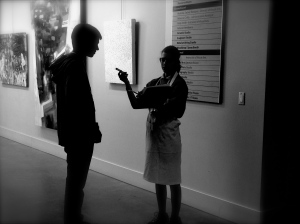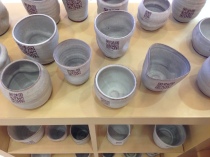 In early June, I packed up the remaining forty-odd cups from FLOW in a large box, loaded them in my trunk, and headed for Interlochen, Michigan. I’d been invited to spend this summer teaching ceramics at Interlochen Center for the Arts Summer Arts Camp, and it felt right to share this project at the faculty art show.
In early June, I packed up the remaining forty-odd cups from FLOW in a large box, loaded them in my trunk, and headed for Interlochen, Michigan. I’d been invited to spend this summer teaching ceramics at Interlochen Center for the Arts Summer Arts Camp, and it felt right to share this project at the faculty art show.
The camp runs in two three-week sessions, and my first session ceramics majors jumped right into the project with only a brief introduction and one quick session of practice. On Thursday, July 3, seven students did over forty interviews at the opening, in less than an hour and a half. Interviewees were campers in grades six through twelve and adult faculty, staff, and guests.
At the end of the evening, only two cups remained on the pedestal. Those disappeared the next day. To our amazement, two additional participants wrote their answers to the questions in a clipboard we had left behind in the gallery.
I’ve seen the QR-coded cups around Interlochen’s campus – cupped in hands, in the cafeteria, in the Writing House, warming tea. By the end of three weeks of great work in the studio, my ceramics majors understood the meaning of ‘flow.’ Kate B. wrote this thoughtful and honest post to share her perspective on the interview experience.
 In complete honesty, interviewing strangers about a concept known as “FLOW” – which we were told little about prior – was not how I wanted to spend my evening.
In complete honesty, interviewing strangers about a concept known as “FLOW” – which we were told little about prior – was not how I wanted to spend my evening.
We were asked – no, closer to requested – to present ourselves, donning clay-splattered aprons, with recording devices and notebooks, pens and agreement forms. Kate commanded we merely interview the strangers about what caused them to lose track of time, have them sign the agreement form (so that the interviews could be posted on cups), and bestow upon them one of the many leftover cups from Kate’s previous installment of the piece.
Soon we were garbed and punctually prepared, standing stoically by the pedestal that held, oh, say 50 of these speckled porcelain vessels. By this time, we had grown in enthusiasm, and everyone wanted to do the first interview.
But when a young girl from the High School Girls division approached, it was I who first excitedly asked, “Are you interested in being interviewed for a cup?”
The answer was yes. I took my patron to the hallway, still empty and quiet what with the earliness of the opening, and commenced the oral questionnaire after receiving, in turn, a signature of agreement. I was ready, so very ready, to hear this young lady pour every inch of her feelings into this little battery-powered box.
What I got was possibly the blandest nonsense I’d ever heard. And then there was the next one, and the next one – by this time my coworkers had also begun interviews – and even more after that. No matter how I worded the questions, no matter how I smiled and tried to seem fascinated as I was pelted with bullet-like one-word answers, no one cared to elaborate, to lose themselves in describing their passion as Kate had promised.
How disappointing, I thought, snapping out of a daze as a confused young Intermediate asked, “Can I have my cup yet?” These people were not interested in FLOW, they were not interested in opening up to a complete stranger as much as myself. And for what? A rock-hard hunk of clay that someone else had put their time into, had lost themselves in?
 I thought about the interviews as I walked back to my division. There were some gems, of course, but for the most part all I got in accordance to passion was sand – dry and numerous. These people only wanted cups; they didn’t want to lose themselves in some pointless interview. They had places to be, but by God, they wanted their cups, and they’d go through the motions just to get one of those smooth, white clay vessels.
I thought about the interviews as I walked back to my division. There were some gems, of course, but for the most part all I got in accordance to passion was sand – dry and numerous. These people only wanted cups; they didn’t want to lose themselves in some pointless interview. They had places to be, but by God, they wanted their cups, and they’d go through the motions just to get one of those smooth, white clay vessels.
It was then that I realized I was in the wrong. There I was, expecting people to ramble about their passion and being thoroughly disappointed, while I only had to look at their motives for tolerating me and my cohorts. These people didn’t care to elaborate on their FLOW – they wanted to experience that of others in a physical form.
Of course.
 In the cups, Kate and her students had created a physical embodiment of losing track of time – they’d spent hours, days, weeks, at wheels, spinning and spinning and throwing and throwing. Over and over again. The interviewees did not want to talk, they wanted to look. Even subconsciously, they were more interested in the passion of others over their own. Isn’t that why people go to art shows, anyways? To see the interests of others take on literal shapes in our plain plane?
In the cups, Kate and her students had created a physical embodiment of losing track of time – they’d spent hours, days, weeks, at wheels, spinning and spinning and throwing and throwing. Over and over again. The interviewees did not want to talk, they wanted to look. Even subconsciously, they were more interested in the passion of others over their own. Isn’t that why people go to art shows, anyways? To see the interests of others take on literal shapes in our plain plane?
Anyone can go out and buy a cup, I remember thinking, but to have to sit through an interview just to get one – by golly, that’s dedication. It was inspiring in that people cared more to own a labor of love than to prattle on to a teenage girl about their own.
Well, good for them! At least someone here is honest with themselves, I thought, embarrassingly recalling how ceaselessly I had spoken about art for my own interview. Enjoy those cups, you uninteresting folk. Enjoy them, because if you simply don’t have a FLOW, you might as well lose yourself in someone else’s.
Would I install FLOW again at a traditional art opening? I’m not so sure. Kate raises some interesting questions to consider here. But it seems I’m going to have to figure this out – because we have a new batch of interviews to share, and so I’ve been making some new cups whenever I have a few minutes to spare in the studio.
Grateful to my ceramics students, all interviewees (willing to talk and eager for cups), Kate B. and her parents, and especially the Interlochen Visual Arts department for the support. And always to the original collaborators.













